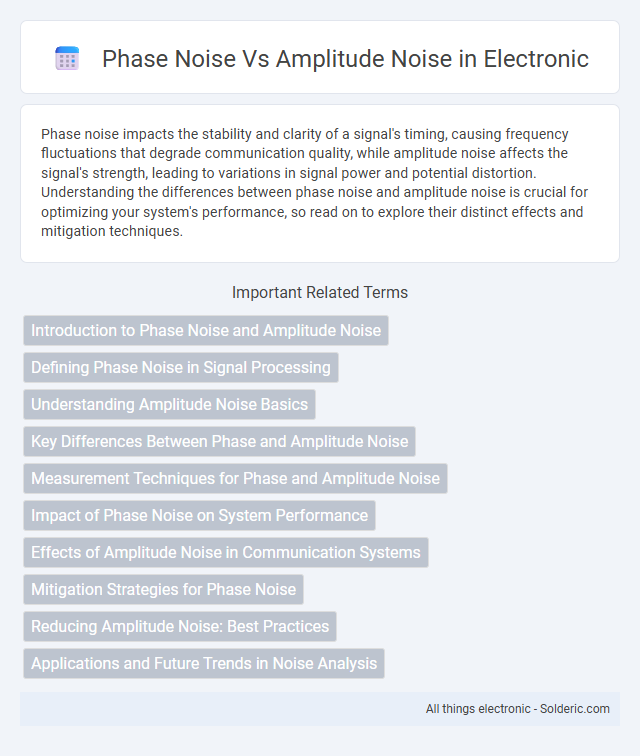Phase noise impacts the stability and clarity of a signal's timing, causing frequency fluctuations that degrade communication quality, while amplitude noise affects the signal's strength, leading to variations in signal power and potential distortion. Understanding the differences between phase noise and amplitude noise is crucial for optimizing your system's performance, so read on to explore their distinct effects and mitigation techniques.
Comparison Table
| Aspect | Phase Noise | Amplitude Noise |
|---|---|---|
| Definition | Random fluctuations in the phase of a signal | Random variations in the signal's amplitude |
| Impact on Signal | Causes spectral spreading and signal jitter | Leads to amplitude distortion and SNR degradation |
| Measurement Unit | dBc/Hz (decibels relative to carrier per Hz) | Usually expressed in dB or voltage variance |
| Common Sources | Oscillator instability, timing jitter | Amplifier noise, power supply fluctuations |
| Effect on Systems | Degrades phase-sensitive applications (e.g., radar, communication) | Reduces signal clarity and dynamic range |
| Mitigation Techniques | Use of low-phase-noise oscillators, phase-locked loops | Amplitude stabilization, automatic gain control (AGC) |
Introduction to Phase Noise and Amplitude Noise
Phase noise refers to the short-term random fluctuations in the phase of a signal, causing spectral spreading around its carrier frequency and impacting the stability of oscillators and communication systems. Amplitude noise involves variations in the signal's magnitude, affecting signal strength and potentially degrading signal-to-noise ratio in electronic circuits and optical systems. Understanding the distinction between phase noise and amplitude noise is critical for optimizing performance in RF design, radar, and high-frequency communication applications.
Defining Phase Noise in Signal Processing
Phase noise in signal processing refers to the rapid, short-term fluctuations in the phase of a signal's waveform, causing spectral spreading around the carrier frequency. Unlike amplitude noise, which affects the signal magnitude, phase noise primarily impacts the signal's frequency stability and coherence, degrading the performance of communication systems and oscillators. Understanding your system's phase noise characteristics is essential for optimizing signal integrity and minimizing errors in high-precision applications.
Understanding Amplitude Noise Basics
Amplitude noise refers to fluctuations in the signal's strength or power, causing variations in the amplitude of the waveform. Unlike phase noise, which affects the timing or phase of the signal, amplitude noise directly impacts signal clarity by introducing distortions in signal amplitude. Understanding amplitude noise basics is crucial for optimizing communication system performance and minimizing signal degradation.
Key Differences Between Phase and Amplitude Noise
Phase noise and amplitude noise differ primarily in their effect on signal integrity; phase noise causes fluctuations in the timing or phase of the carrier wave, while amplitude noise affects the signal's strength or magnitude. Phase noise is critical in communication systems because it can degrade the bit error rate and signal clarity, especially in frequency modulation or phase modulation schemes. Your system's performance can be optimized by minimizing phase noise for accurate timing and reducing amplitude noise to maintain signal amplitude consistency.
Measurement Techniques for Phase and Amplitude Noise
Measurement techniques for phase noise primarily utilize phase-locked loops (PLLs) and spectrum analyzers with cross-correlation methods to isolate and quantify noise close to the carrier frequency. Amplitude noise measurement often employs envelope detectors or RMS detectors combined with low-noise amplifiers to accurately capture amplitude fluctuations without distortion. Digital signal processing (DSP) enables advanced noise separation and real-time analysis, enhancing measurement precision for both phase and amplitude noise in oscillator and communication systems.
Impact of Phase Noise on System Performance
Phase noise degrades system performance by causing spectral spreading and reducing signal integrity, leading to increased bit error rates in communication systems. It directly affects the stability and accuracy of oscillators, compromising synchronization and frequency demodulation. Unlike amplitude noise, phase noise primarily disrupts phase-sensitive applications, such as radar and high-frequency wireless transmissions.
Effects of Amplitude Noise in Communication Systems
Amplitude noise in communication systems primarily degrades the signal-to-noise ratio (SNR), leading to increased bit error rates (BER) and reduced data integrity. Unlike phase noise, which affects the signal's phase stability and causes jitter in the carrier, amplitude noise directly impacts the signal's strength, causing fluctuations that can distort amplitude modulated signals and impair receiver sensitivity. Managing amplitude noise is crucial for maintaining reliable communication links, especially in amplitude modulation (AM) and quadrature amplitude modulation (QAM) systems where signal amplitude encodes critical information.
Mitigation Strategies for Phase Noise
Mitigation strategies for phase noise involve improving oscillator design by using high-quality resonators, low-noise components, and phase-locked loops (PLLs) to stabilize signal frequency. Implementing filtering techniques and temperature compensation further reduces phase instability in communication systems. Your system's performance can be enhanced by selecting components with low intrinsic phase noise and employing advanced signal processing algorithms.
Reducing Amplitude Noise: Best Practices
Reducing amplitude noise is essential for improving signal integrity in communication systems and measurement instruments. Best practices include using low-noise amplifiers, implementing proper shielding and grounding techniques, and employing amplitude stabilization circuits to maintain consistent signal strength. You can also minimize amplitude noise by optimizing the power supply quality and carefully selecting components with low intrinsic noise characteristics.
Applications and Future Trends in Noise Analysis
Phase noise significantly impacts high-frequency communication systems and radar applications by degrading signal purity, necessitating advanced noise reduction techniques for improved system performance. Amplitude noise affects precision measurements and sensor accuracy, driving research toward adaptive filtering and real-time noise compensation methods. Future trends in noise analysis emphasize machine learning algorithms and quantum noise control to enhance signal integrity across emerging technologies such as 5G networks and quantum computing.
Phase noise vs amplitude noise Infographic

 solderic.com
solderic.com